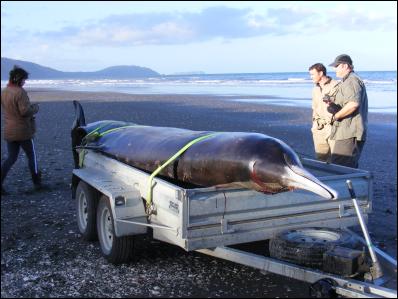Rare beaked whale strands on Kapiti coast
29 January 2009

A rare Gray’s beaked whale which stranded and subsequently died on a Kapiti beach this week may have been nursing a calf.
The 4.8 metre female whale was found on the beach just south of Whareroa Stream mouth, between Raumati and Paekakariki on Tuesday afternoon, by Department of Conservation staff responding to a call from the public. The whale died soon after they arrived at the scene.
Preliminary findings of an autopsy undertaken yesterday by Te Papa Marine Mammal Collections Manager Anton van Helden have shown that the whale was pregnant with a 20cm foetus in her uterus.
“Surprisingly it appears she may have also been nursing a calf as there was milk discharging from her mammary glands,” Mr van Helden said.
However there has been no sign of the calf and DOC is appealing to the public to keep an eye out for it and report to it any sightings or strandings to the 0800 DOC HOTline (0800 362 468).
“It is unlikely that the calf will be able to fend for itself without its mother but it will depend on the age of the animal and whether it was near weaning,” Mr van Helden said.
He was excited by the discovery of the whale which would provide a valuable insight into the breeding of its species.
DOC biodiversity programme manager Richard Gill said the whale was in excellent body condition apart from abrasions on its tail, likely to have been caused by being stranding on the beach, and a fresh bite mark on its abdomen, caused by a cookie cutter shark. Such bites are common on beaked whales and because the bites are relatively small and superficial the wounds do not cause serious injury to the animal. This wound is unlikely to be related to the whale stranding and its subsequent death.
The whale was buried where it stranded yesterday. The whale and the burial site were blessed by Te Runanga o Te Ati Awa ki Whakarongotai.
The whale’s head will be held at Te Papa
for further study as part of a national project to determine
variability in the anatomy of the skulls in the NZ Gray’s
beaked whale population.
Facts about Gray’s beaked
whales Mesoplodon grayi
• They have a national DOC threat classification of 'data deficient' because so little is known about them.
• They typically
grow to about 5.5m long.
• Most have tiny maxillary
teeth in upper jaw, but the adult males have two exposed
tusks/teeth in the lower jaw (one on each side), while
females will have a small tooth that is not exposed above
the gum line.
• They are the most common species of beaked whale that strand in New Zealand and the only species of beaked whale that is known to mass strand.
• They were first described by Julius von Haast after a stranding of 28 animals in the 1860s on the Chatham Islands.
• There are 21 species of beaked whale that are currently recognised worldwide, of which 12 occur in New Zealand waters. Five of the 21 species were first described from animals stranded in NZ.
• With a few exceptions, many of the species are known from only a handful of specimens.
• NZ has the greatest number of different species of beaked whales in the world.
• They are rarely seen at sea because of their elusive habits, preference for deep ocean waters and possible low abundance. Most of what is known about them has come from strandings.
• They are usually seen single, in pairs or in small groups.
• They are deep divers and feed largely on soft bodied animals like squid.
More information about
Gray’s beaked whales can be found on the Te Ara webite:
http://www.teara.govt.nz/EarthSeaAndSky/SeaLife/Whales/7/en
Caption: The Gray’s beaked whale which stranded on the Kapiti coast. Photo: Richard Gill/Department of Conservation.
ENDS


 FSCL: Woman Scammed Out Of $25,000 After Job Offer On LinkedIn
FSCL: Woman Scammed Out Of $25,000 After Job Offer On LinkedIn NIWA: Cheers To Crustaceans - New Species Named After Welly Brewery
NIWA: Cheers To Crustaceans - New Species Named After Welly Brewery MBIE: Trans-Tasman Earth Observation Research Studies Confirmed
MBIE: Trans-Tasman Earth Observation Research Studies Confirmed NZ Association of Scientists: Royal Society Te Apārangi Governance Submissions Close - NZAS Submission
NZ Association of Scientists: Royal Society Te Apārangi Governance Submissions Close - NZAS Submission HortPlus: Project Aims To Improve Quality Of Weather Data In New Zealand
HortPlus: Project Aims To Improve Quality Of Weather Data In New Zealand Air New Zealand: Air New Zealand And Cathay Pacific Welcome New Zealand Ministerial Approval To Extend Partnership
Air New Zealand: Air New Zealand And Cathay Pacific Welcome New Zealand Ministerial Approval To Extend Partnership



